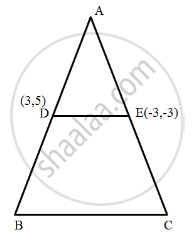Advertisements
Advertisements
प्रश्न
If the coordinates of the sides AB and AC of ∆ABC are (3, 5) and (−3, −3), respectively, then write the length of side BC.
उत्तर
Disclaimer: In the question it should have been the coordinates of the mid points of AB and AC are (3, 5) and (-3, -3) 
Given: the coordinates of the midpoints of AB and AC are (3,5) and (-3, -3).
Let, D and E be the midpoints of AB and AC, respectively.
\[\therefore DE = \sqrt{\left[ 3 - \left( - 3 \right) \right]^2 + \left[ 5 - \left( - 3 \right) \right]^2}\]
\[ = \sqrt{6^2 + 8^2}\]
\[ = \sqrt{100}\]
= 10 units
Now, as D and E are midpoints of AB and AC respectively,
by the mid-points theorem,
\[BC = 2 \times DE\]
= 2 x 10 units
= 20 units
APPEARS IN
संबंधित प्रश्न
Four points A (6, 3), B (−3, 5), C (4, −2) and D (x, 3x) are given in such a way that \[\frac{\Delta DBC}{\Delta ABC} = \frac{1}{2}\]. Find x.
The points A (2, 0), B (9, 1), C (11, 6) and D (4, 4) are the vertices of a quadrilateral ABCD. Determine whether ABCD is a rhombus or not.
The base of an equilateral triangle with side 2a lies along the y-axis, such that the mid-point of the base is at the origin. Find the vertices of the triangle.
Find the distance between P (x1, y1) and Q (x2, y2) when (i) PQ is parallel to the y-axis (ii) PQ is parallel to the x-axis.
Find the equation of the locus of a point which moves such that the ratio of its distances from (2, 0) and (1, 3) is 5 : 4.
A point moves so that the difference of its distances from (ae, 0) and (−ae, 0) is 2a. Prove that the equation to its locus is \[\frac{x^2}{a^2} - \frac{y^2}{b^2} = 1\]
Find the locus of a point such that the sum of its distances from (0, 2) and (0, −2) is 6.
Find the locus of a point which is equidistant from (1, 3) and the x-axis.
Find the locus of a point which moves such that its distance from the origin is three times its distance from the x-axis.
A (5, 3), B (3, −2) are two fixed points; find the equation to the locus of a point P which moves so that the area of the triangle PAB is 9 units.
If A (−1, 1) and B (2, 3) are two fixed points, find the locus of a point P, so that the area of ∆PAB = 8 sq. units.
A rod of length l slides between two perpendicular lines. Find the locus of the point on the rod which divides it in the ratio 1 : 2.
What does the equation (a − b) (x2 + y2) −2abx = 0 become if the origin is shifted to the point \[\left( \frac{ab}{a - b}, 0 \right)\] without rotation?
Find what the following equation become when the origin is shifted to the point (1, 1).
x2 − y2 − 2x +2y = 0
Find what the following equation become when the origin is shifted to the point (1, 1).
xy − x − y + 1 = 0
Find what the following equation become when the origin is shifted to the point (1, 1).
xy − y2 − x + y = 0
Find what the following equation become when the origin is shifted to the point (1, 1).
x2 + xy − 3y2 − y + 2 = 0
Find what the following equation become when the origin is shifted to the point (1, 1).
xy − y2 − x + y = 0
Find what the following equation become when the origin is shifted to the point (1, 1).
xy − x − y + 1 = 0
Find what the following equation become when the origin is shifted to the point (1, 1).
x2 − y2 − 2x + 2y = 0
Find the point to which the origin should be shifted after a translation of axes so that the following equation will have no first degree terms: y2 + x2 − 4x − 8y + 3 = 0
Find the point to which the origin should be shifted after a translation of axes so that the following equation will have no first degree terms: x2 + y2 − 5x + 2y − 5 = 0
Verify that the area of the triangle with vertices (4, 6), (7, 10) and (1, −2) remains invariant under the translation of axes when the origin is shifted to the point (−2, 1).
The vertices of a triangle are O (0, 0), A (a, 0) and B (0, b). Write the coordinates of its circumcentre.
In Q.No. 1, write the distance between the circumcentre and orthocentre of ∆OAB.
Write the coordinates of the orthocentre of the triangle formed by points (8, 0), (4, 6) and (0, 0).
Three vertices of a parallelogram, taken in order, are (−1, −6), (2, −5) and (7, 2). Write the coordinates of its fourth vertex.
If the points (1, −1), (2, −1) and (4, −3) are the mid-points of the sides of a triangle, then write the coordinates of its centroid.
Write the area of the triangle with vertices at (a, b + c), (b, c + a) and (c, a + b).
